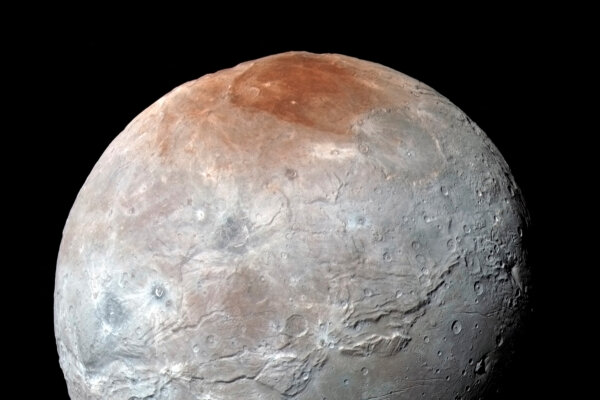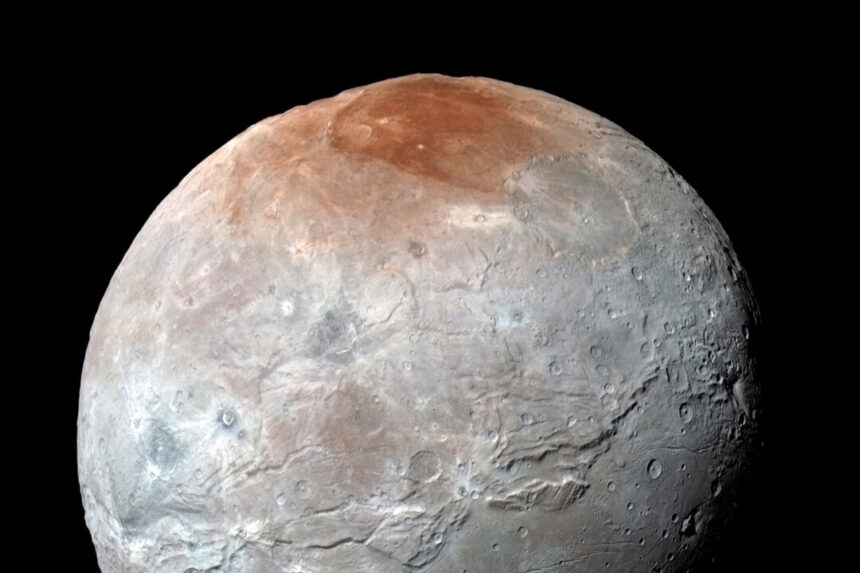
Observations by the James Webb Space Telescope are providing scientists with a more comprehensive understanding of the composition and evolution of Pluto’s largest moon, Charon, which orbits one of our solar system’s dwarf planets.
For the first time, Webb detected carbon dioxide and hydrogen peroxide—both frozen as solids—on Charon’s surface, a spherical body approximately 750 miles (1,200 km) in diameter, researchers revealed on Tuesday. These findings add to the previously documented water ice, ammonia-bearing compounds, and organic materials on Charon’s surface.
Charon, found in 1978, is notable for being the largest moon in the solar system relative to the planet it orbits. It is roughly half the diameter and an eighth of the mass of Pluto, a dwarf planet located in the Kuiper Belt, a cold region of the outer Solar System beyond Neptune, the most distant planet.
The distance between Charon and Pluto is about 12,200 miles (19,640 km), compared to Earth’s average distance of 238,855 miles (384,400 km) from its moon.
Most of Charon’s surface appears gray, with reddish-brown regions near its poles made up of organic materials.
The Webb observations build upon data collected when NASA’s New Horizons spacecraft passed by Charon during its exploration of the Pluto system in 2015. The study leveraged Webb’s capability, launched in 2021 and started gathering data the following year, to observe across a broader range of wavelengths than previously possible.
The presence of hydrogen peroxide indicates the irradiation processes Charon has undergone over time, while the carbon dioxide likely dates back to the moon’s formation around 4.5 billion years ago.
The researchers noted that hydrogen peroxide formed as water ice on Charon’s surface was chemically altered by continuous exposure to ultraviolet radiation from the sun, energetic particles from the solar wind, and cosmic rays from the galaxy.
The carbon dioxide observed by Webb was likely buried beneath the surface and exposed by impacts on Charon. This carbon dioxide probably originated from the material that formed both Charon and Pluto.
Scientists were surprised that carbon dioxide had not been previously detected.
“The discovery of carbon dioxide was a gratifying confirmation of our expectations,” said Silvia Protopapa, assistant director of the Department of Space Studies at the Southwest Research Institute in Boulder, Colorado, co-investigator of the New Horizons mission, and the lead author of the study published in the journal Nature Communications.
“The detection of hydrogen peroxide on Charon was unexpected. I honestly did not anticipate finding evidence of it on the surface,” Protopapa added.
The new insights into Charon contribute to a broader understanding of the various celestial bodies in our solar system.
“Every small body in the outer solar system is a unique piece of a larger puzzle that scientists are trying to piece together,” Protopapa remarked.
The researchers utilized Webb’s Near-Infrared Spectrograph to conduct four observations in 2022 and 2023, providing complete coverage of Charon’s northern hemisphere.
“These recent Webb observations introduce carbon dioxide and hydrogen peroxide to the known components of Charon’s surface. Both of these findings offer insights into the ongoing processes of irradiation and impact-driven resurfacing,” said study co-author Ian Wong, a staff scientist at the Space Telescope Science Institute in Baltimore.
By Will Dunham





